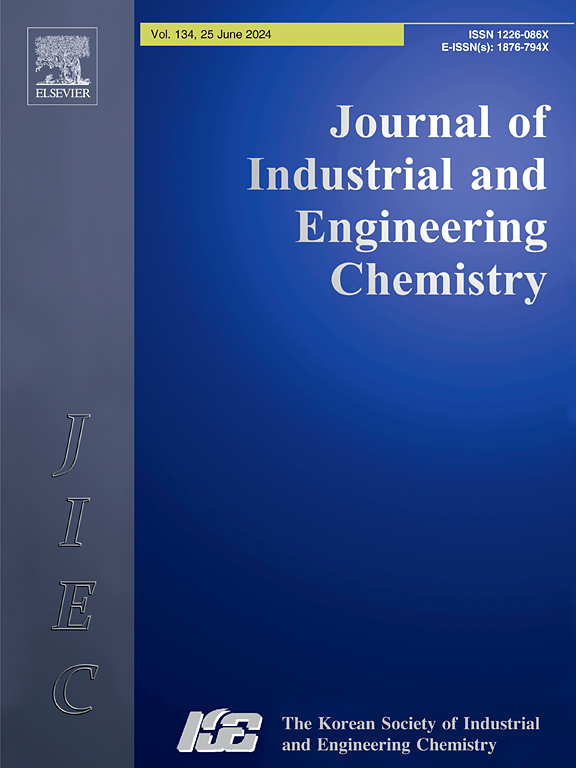烹饪油烟污垢的化学成分和粘附性能:实验研究和分子模拟
IF 5.9
3区 工程技术
Q1 CHEMISTRY, MULTIDISCIPLINARY
Journal of Industrial and Engineering Chemistry
Pub Date : 2024-11-29
DOI:10.1016/j.jiec.2024.11.030
引用次数: 0
摘要
为了有效去除烹饪产生的油烟污垢,有必要了解污垢的化学成分,其在老化过程中的演变,以及它对粘附性能的影响。本研究以大豆油为原料,进行了污染模拟。采用气相色谱-质谱、核磁共振等分析不同老化时间后的化学成分。通过分子动力学模拟研究了相互作用能。分析结果表明,污染成分由亚油酸-亚油酸-亚油酸甘油三酯(LLL)、棕榈酸-亚油酸-亚麻酸甘油三酯(PLLn)和亚油酸-亚油酸-油酸甘油三酯(LLO)逐渐演变为一次氧化产物(氢过氧化物)和二次氧化产物(如环氧化物、醇类和醛类)。仿真结果表明,随着老化过程的进行,污垢分子间、污垢层间、污垢与基体间的相互作用能不断增大。前两者归因于范德华相互作用的增加,而后者归因于氧化产物引起的静电相互作用的增加。同时,两层结垢层之间的最弱相互作用能是结垢附着过程的一个弱点。对污垢层和污垢基板剥离力的实验测量验证了仿真结果。这些发现可以指导污垢清洗剂的设计和开发。本文章由计算机程序翻译,如有差异,请以英文原文为准。

The chemical components and adhesion performance of the oil fume fouling sourced from cooking: Experimental investigation and molecular simulation
To effectively remove cooking-generated oil fume fouling, it is necessary to understand the chemical compositions of fouling, its evolution in the aging process, and its effects on adhesion performance. In this study, the fouling was simulated using soybean oil. The chemical compositions after undergoing different aging time were analyzed by GC–MS, 1H NMR, and so on. The interaction energies were investigated by the molecular dynamic simulation. The analysis results showed that fouling composition gradually evolved from linoleic-linoleic-linoleic triglyceride (LLL), palmitic-linoleic-linolenic triglyceride (PLLn), and linoleic-linoleic-oleic triglyceride (LLO) to primary oxidation products (hydroperoxides) and secondary oxidation products (such as epoxides, alcohols, and aldehydes). The simulation found that the interaction energies between molecules in fouling, between fouling layers, and between fouling and substrate increased continuously during aging. The former two were attributed to the increases in van der Waals interactions, while the latter was attributed to the rise in electrostatic interactions caused by oxidation products. Meanwhile, the weakest interaction energy between two fouling layers was a vulnerability of the fouling adhesion process. The experimental measurement of peeling force of fouling layers and fouling-substrate verified the simulation results. These findings can guide the design and development of the cleaning agents for fouling.
求助全文
通过发布文献求助,成功后即可免费获取论文全文。
去求助
来源期刊
CiteScore
10.40
自引率
6.60%
发文量
639
审稿时长
29 days
期刊介绍:
Journal of Industrial and Engineering Chemistry is published monthly in English by the Korean Society of Industrial and Engineering Chemistry. JIEC brings together multidisciplinary interests in one journal and is to disseminate information on all aspects of research and development in industrial and engineering chemistry. Contributions in the form of research articles, short communications, notes and reviews are considered for publication. The editors welcome original contributions that have not been and are not to be published elsewhere. Instruction to authors and a manuscript submissions form are printed at the end of each issue. Bulk reprints of individual articles can be ordered. This publication is partially supported by Korea Research Foundation and the Korean Federation of Science and Technology Societies.

 求助内容:
求助内容: 应助结果提醒方式:
应助结果提醒方式:


